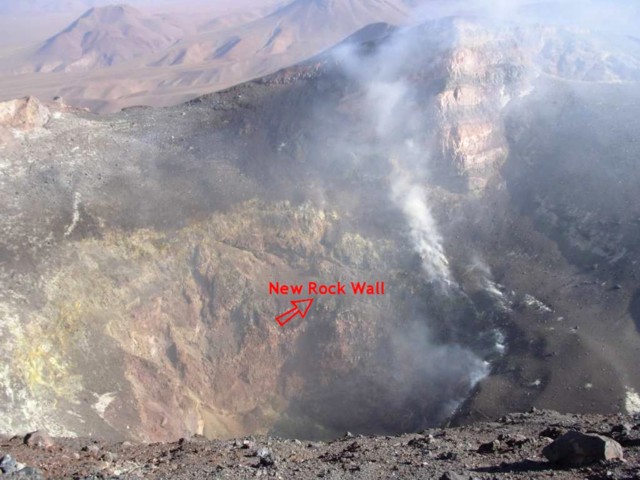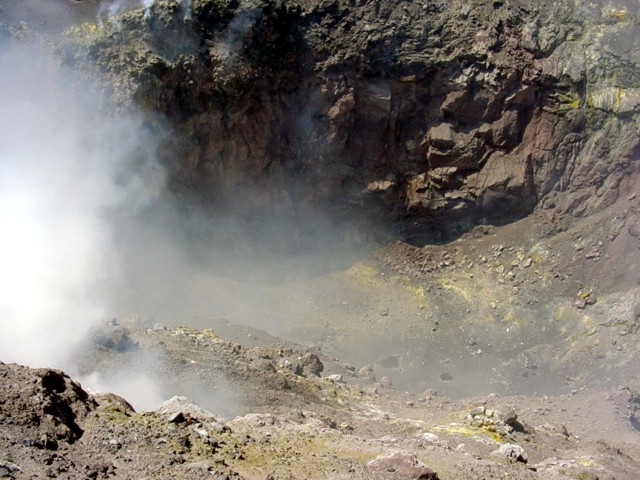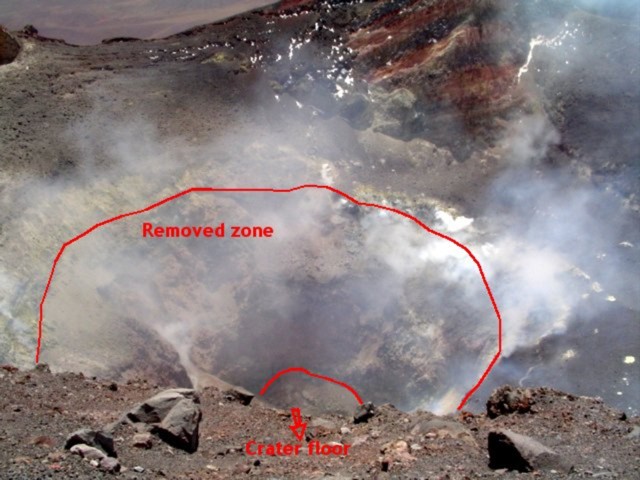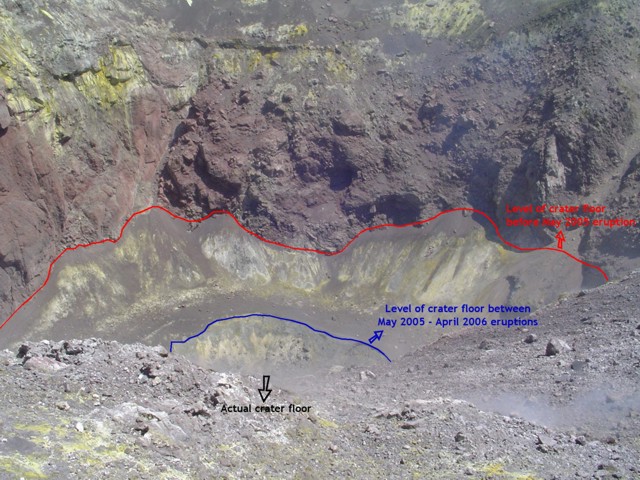Report on Lascar (Chile) — November 2006
Bulletin of the Global Volcanism Network, vol. 31, no. 11 (November 2006)
Managing Editor: Richard Wunderman.
Lascar (Chile) Crater changes after May; minor explosions during September and October 2006
Please cite this report as:
Global Volcanism Program, 2006. Report on Lascar (Chile) (Wunderman, R., ed.). Bulletin of the Global Volcanism Network, 31:11. Smithsonian Institution. https://doi.org/10.5479/si.GVP.BGVN200611-355100
Lascar
Chile
23.37°S, 67.73°W; summit elev. 5592 m
All times are local (unless otherwise noted)
This report covers the time interval September-October 2006 and was contributed by scientists from the Universidad Católica del Norte (Chile), University of Florence (Italy), Universidad Nacional de Salta (Argentina), and Universidad Nacional Autónoma de México (México). Changes seen in Láscar's central active crater after the May 2005 and April 2006 eruptions and after the gas fumaroles investigation carried out during September 2006. Our previous report covered activity into early May 2006 (BGVN 31:04).
Eruptive activity. Substantial ash emissions were noted on 18-21 and 28 April 2006. Several small phreatic explosions occurred starting 18April, continuing through May, July, and August 2006; the last in that time frame occurring on 14 August. After that, three minor explosions occurred between September and October 2006.
An explosion occurred at 0812 on 21 September. The eruptive plume reached 800 m above summit crater. A dark gray-colored plume, with moderate ash content dispersed NNE. The event failed to produce detectable ashfall, seismic activity, or eruption noises.
A minor explosion at 0830 on 20 October 2006 sent an eruptive plume up to 200 m above the summit crater. A dark gray-colored plume with moderate ash content dispersed E. At 1900 a larger eruption lasted 25 minutes. A dark gray-colored plume with moderate ash content reached 800 m above the summit crater and dispersed E. The October events also did not produce detected ashfall, seismic activity, or eruption noises.
Morphological changes in central active crater. Significant morphological changes, principally to the crater floor, occurred after the May 2005 Vulcanian eruption (Aguilera and others, 2006a; BGVN 30:04 and 30:05). Field and aerial observations between October 2002 and March 2005 showed a typical funnel shaped crater, with a depth of 450 m (Aguilera and others, 2003). This phenomena has been recognized as always occurring during the collapse-period of the lava dome growth-collapse cycle described by Matthews and others (1997). The observations during October 2002 and March 2005 show that the crater floor can be recognized from the S border of the central active crater (figure 37). However, observations during December 2005 (after the May 2005 Vulcanian eruption) and September 2006 (after the April 2006 eruptive cycle) show that the crater floor cannot be recognized from S border of central active crater (figure 38), probably indicating subsidence of the crater floor (Aguilera and others, 2006b; BGVN 31:04; and Clavero and others, 2006). Observations made in the central active crater indicate subsidence of crater floor.
 |
Figure 38. Central active crater of Lascar viewed from S side. Shown is the new rock wall of the inner crater after May 2005 Vulcanian eruption. Photograph taken by Felipe Aguilera, December 2005. |
The photograph from October 2002 (figure 39) shows the position of the crater floor inferred just before the May 2005 eruption, while the photograph from September 2006 (figure 40) shows the crater floor after the May 2005 and April 2006 eruptions. The position of the crater floor before the May 2005 eruption corresponded to a level associated with talus deposits, and the latest crater floor lay at the bottom of a new circular crater. A notable change in the morphology of the internal walls of the central active crater between the March and December 2005 photographs was the absence of a part of the crater wall (probably corresponding to parts of ancient lava domes, ballistic and ashfall deposits), exposing a new N wall of the crater.
 |
Figure 39. Central active crater of Lascar seen from the N internal wall, October 2002. Photograph taken by Franco Tassi. |
Gas fumarole investigations. During 9-15 September 2006, gas sampling from fumaroles inside the central active crater was carried out by personnel of Universidad Católica del Norte (Chile). They noted a lowering of the temperature of fumaroles from 385°C to 250°C in October 2002 (Tassi and others, 2004). Scientists from Università degli studi di Firenze (Italy) and Universidad Católica del Norte (Chile) are conducting a systematic and permanent gas sampling campaign at Láscar and other active volcanoes of the Central Volcanic Zone (e.g. Putana, Lastarria, Isluga and others). Scientists from the Universidad Católica del Norte, the Universidad Nacional de Salta and SEGEMAR (Argentina) are processing data from Landsat TM and ETM+ and from ASTER images, with the objective of understanding the behavior of Lascar volcano during the 1998-2004 period.
References. Aguilera, F., Viramonte, J., Medina, E., Guzmán, K., Becchio, R., Delgado, H., and Arnosio, M., 2006a, Eruptive activity from Lascar volcano (2003-2005): XI Congreso Geológico Chileno, Antofagasta, 2006, p. 397-400.
Aguilera, F., Viramonte, J., Medina, E., Guzmán, K., Becchio, R., Delgado, H., and Arnosio, M., 2006b, Recent eruptive activity from Lascar volcano (2006): XI Congreso Geológico Chileno, Antofagasta, 2006, p. 393-396.
Clavero, J., Naranjo, J., and Cayupi, J., 2006, El ciclo eruptivo del 18 al 25 de Abril de 2006 del Volcán Lascar, Andes Centrales: XI Congreso Geológico Chileno, Antofagasta, 2006, p. 435-438.
Giggenbach, W., 1975, A simple method for the collection and analysis of volcanic gas samples: Bulletin of Volcanology, v. 39, p. 132-145.
Giggenbach, W., and Goguel, R., 1989, Collection and analysis of geothermal and volcanic water and gas discharges: DSIR Chemistry, Rept. No. 2401.
Matthews, S., Gardeweg, M., and Sparks, R., 1997, The 1984 to 1996 cyclic activity of Lascar volcano, northern Chile: cycles of dome growth, dome subsidence, degassing and explosive eruptions: Bulletin of Volcanology, v. 59, p. 72 - 82
Tassi, F., Viramonte, J., Vaselli, O., Poodts, M., Aguilera, F., Martínez, C., Rodríguez, L., and Watson, I., 2004, First geochemical data from fumarolic gases at Lascar volcano, Chile: 32nd International Geological Congress, Florence, August 20-28, 2004.
Viramonte, J., Aguilera, F., Delgado, H., Rodríguez, L., Guzman, K., Jiménez, J., and Becchio, R., 2006, A new eruptive cycle of Lascar volcano (Chile). The risk for the aeronavigation in northern Argentina: Garavolcan 2006, Tenerife, Spain.
Geological Summary. Láscar is the most active volcano of the northern Chilean Andes. The andesitic-to-dacitic stratovolcano contains six overlapping summit craters. Prominent lava flows descend its NW flanks. An older, higher stratovolcano 5 km E, Volcán Aguas Calientes, displays a well-developed summit crater and a probable Holocene lava flow near its summit (de Silva and Francis, 1991). Láscar consists of two major edifices; activity began at the eastern volcano and then shifted to the western cone. The largest eruption took place about 26,500 years ago, and following the eruption of the Tumbres scoria flow about 9000 years ago, activity shifted back to the eastern edifice, where three overlapping craters were formed. Frequent small-to-moderate explosive eruptions have been recorded since the mid-19th century, along with periodic larger eruptions that produced ashfall hundreds of kilometers away. The largest historical eruption took place in 1993, producing pyroclastic flows to 8.5 km NW of the summit and ashfall in Buenos Aires.
Information Contacts: Felipe Aguilera, Eduardo Medina, Karen Guzmán, and Valeria Ortega, Programa de Doctorado en Ciencias mención Geología and Depto de Ciencias Geológicas, Univ Católica del Norte, Avenida Angamos 0610, Antofagasta, Chile; Franco Tassi and Orlando Vaselli, Dept of Earth Science, Univ of Florence, Via La Pira 4, 50110, Florence, Italy (URL: http://www.geo.unifi.it/); José G. Viramonte, Instituto GEONORTE and CONICET, Univ Nacional de Salta, Buenos Aires 177, Salta 4400, Argentina (URL: http://www.unsa.edu.ar/); Hugo Delgado G., Instituto de Geofísica, Univ Nacional Autónoma de México, Ciudad Universitaria, Del Coyoacán, México D.F., C.P. 04510, México (URL: http://www.igeofcu.unam.mx/).



